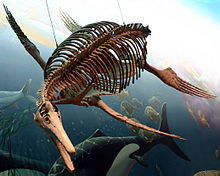长喙龙属
长喙龙属(属名:Dolichorhynchops)是种海生爬行动物,属于蛇颈龙目双臼椎龙科,生存于白垩纪晚期的北美洲。属名意为“具有长鼻的眼睛”,意指其眼睛的位置接近长口鼻部。
| 长喙龙属 化石时期:
| |
|---|---|

| |
| 生存于白垩纪北美洲的奥氏长喙龙 | |
| 科学分类 | |
| 界: | 动物界 Animalia |
| 门: | 脊索动物门 Chordata |
| 纲: | 爬行纲 Reptilia |
| 目: | †蛇颈龙目 Plesiosauria |
| 科: | †双臼椎龙科 Polycotylidae |
| 属: | †长喙龙属 Dolichorhynchops Williston, 1902 |
| 模式种 | |
| 奥氏长喙龙 Dolichorhynchops osborni Williston, 1902
| |
| 种 | |
| |
奥氏长喙龙 编辑
奥氏长喙龙的模式标本(编号KUVP 1300 (页面存档备份,存于互联网档案馆))是在1900年发现,由乔治·史登柏格(George F. Sternberg)发现于堪萨斯州洛根县的斯莫基希尔河白垩层。史登柏格与父亲查尔斯·斯腾伯格(Charles H. Sternberg)将化石送到堪萨斯大学。化石由H.T. Martin与S.W. Williston处理并架设,并在1902年命名、叙述,名为奥氏长喙龙(D. osborni)。这个化石目前在堪萨斯大学自然历史博物馆展出中。
在1918年,查尔斯·斯腾伯格发现一个海王龙化石,其胃部区域 Archive.is的存档,存档日期2012-06-29有个蛇颈龙类化石。在1922年,斯腾伯格简述这个标本,然后被科学界长期遗忘,直到21世纪才被再度重视、研究。这个海王龙标本目前在华圣顿史密森尼博物馆展出中。国家地理频道在2007年制作的IMAX电影《海中巨怪》(Sea Monsters),即是以这个标本为故事的起点。
在1926年,斯腾伯格发现第二个奥氏长喙龙的标本,较不完整。斯腾伯格将这个化石拍了照片 (页面存档备份,存于互联网档案馆),然后送到哈佛大学比较动物学博物馆。 MCZ 1064 (页面存档备份,存于互联网档案馆)但这个标本要到2004年才由F. R. O'Keefe完整的叙述。
奥氏长喙龙的最完整化石 (页面存档备份,存于互联网档案馆)是在50年代早期发现,由Marion Bonner发现于洛根县。该化石的长度只有约3公尺。头骨虽然遭到挤压变形,但整体状态良好。该化石先后由斯腾伯格、Orville Bonner所研究。Orville Bonner当时将这个化石归类于三尖股龙(Trinacromerum)的一个种。
在1997年,怀俄明州皮耳页岩发现两个大型双臼椎龙科化石[1] (页面存档备份,存于互联网档案馆)。在1997年,研究人员将两个化石归类于Trinacromerum bonneri。但在1996年,肯尼思·卡彭特(Kenneth Carpenter)研究双臼椎龙科,提出长喙龙与Trinacromerum是不同的属。这两个化石因此改为长喙龙的一个种(D. bonneri),但这个种是否是独立的种,或是奥氏长喙龙的大型个体,仍在争议中。
奥氏长喙龙的化石大多出土于莫基希尔河白垩层。在2003年,一个奥氏长喙龙化石被发现于较下层的白垩层,年代属于康尼亚克阶晚期/桑托阶。在2005年,堪萨斯州朱厄尔县的Fort Hays石灰层发现一个奥氏长喙龙化石。
赫歇尔长喙龙 编辑
在2005年描述了新种赫歇尔长喙龙(D. herschelensis)。化石发现于加拿大萨克其万省的Bearpaw组地层,这是一个晚白垩纪(晚坎潘阶到马斯垂克阶)地层。化石发现地点接近萨克其万省西南部的赫歇尔镇,所以取名为赫歇尔长喙龙。这组地层包含砂岩、泥岩、页岩,在白垩纪该地为西部内陆海道(Western Interior Seaway)。
赫歇尔长喙龙的模式标本的关节脱落、呈非天然状态,化石散布于挖掘基地内。头颅骨、下颌、肋骨、骨盆、与肩胛骨都被挖掘出来,但脊椎并不完整,所以目前并不清楚长喙龙脊椎骨的正确数量。四肢都已失散,附近发现了9个小型指骨,以及少量的四肢骨头,但不确定它们是否属于赫歇尔长喙龙。
赫歇尔长喙龙的标本被认为是成年体。赫歇尔长喙龙被认为比奥氏长喙龙还小,有些未成年奥氏长喙龙的样本比成年的赫歇尔长喙龙还大。假设赫歇尔长喙龙只有少数脊椎骨失散的话,它们身长应为2.5到3公尺。它们有细长的口鼻部,以及大量的齿槽。然而只有少数锐利牙齿被保存下来。
参考资料 编辑
- Adams, D. A. 1977. Trinacromerum bonneri, a new polycotylid plesiosaur from the Pierre Shale of South Dakota and Wyoming. Unpublished Masters thesis, University of Kansas, 97 pages.
- Adams, D. A., 1997. Trinacromerum bonneri, new species, last and fastest pliosaur of the Western Interior Seaway. Texas Journal of Science, 49(3):179-198.
- Bonner, O. W. 1964. An osteological study of Nyctosaurus and Trinacromerum with a description of a new species of Nyctosaurus, Unpub. Masters Thesis, Fort Hays State University, 63 pages.
- Carpenter, K. 1996. A Review of short-necked plesiosaurs from the Cretaceous of the western interior, North America, Neues Jahrbuch für Geologie und Paläeontologie Abhandlungen, (Stuttgart) 201(2):259-287.
- Everhart, M. J. 2003. First records of plesiosaur remains in the lower Smoky Hill Chalk Member (Upper Coniacian) of the Niobrara Formation in western Kansas. Kansas Academy of Science, Transactions 106(3-4):139-148.
- Everhart, M. J. 2004a. Plesiosaurs as the food of mosasaurs; new data on the stomach contents of a Tylosaurus proriger (Squamata; Mosasauridae) from the Niobrara Formation of western Kansas. The Mosasaur 7:41-46.
- Everhart, M. J. 2004b. New data regarding the skull of Dolichorhynchops osborni (Plesiosauroidea: Polycotylidae) from rediscovered photos of the Harvard Museum of Comparative Zoology specimen. Paludicola 4(3):74-80.
- Everhart, M. J. 2005. Oceans of Kansas - A Natural History of the Western Interior Sea. Indiana University Press, 322 pp.
- Everhart, M.J., R. Decker and P. Decker. 2006. Earliest remains of Dolichorhynchops osborni (Plesiosauria: Polycotylidae) from the basal Fort Hays Limestone, Jewell County, Kansas. Kansas Academy of Science, Transactions 109(3-4): 261 (abstract).
- Everhart, M. J. 2007. Sea Monsters: Prehistoric Creatures of the Deep. National Geographic, 192 p. ISBN 978-1426200854
- O'Keefe, F. R. 2004. On the cranial anatomy of the polycotylid plesiosaurs, including new material of Polycotylus latipinnis Cope, from Alabama. Journal of Vertebrate Paleontology 24(2):326-340.
- Sato, T., 2005. A new Polycotylid Plesiosaur (Reptilia: Sauropterygia) from the Upper Cretaceous Bearpaw Formation in Saskatchewan, Canada. Journal of Paleontology, 79: 969-980.
- Sternberg, C. H. 1922. Explorations of the Permian of Texas and the chalk of Kansas, 1918. Kansas Academy of Science, Transactions 30(1): 119-120.
- Sternberg, G. F. and M. V. Walker. 1957. Report on a plesiosaur skeleton from western Kansas. Kansas Academy of Science, Transactions, 60(1):86-87.
- Williston, S. W. 1902. Restoration of Dolichorhynchops osborni, a new Cretaceous plesiosaur, Kansas University Science Bulletin, 1(9):241-244, 1 plate.
- Williston, S. W. 1903. North American plesiosaurs, Field Columbian Museum, Pub. 73, Geological Series, 2(1):1-79, 29 plates.